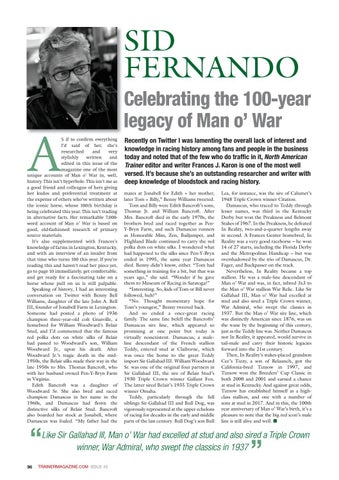SID FERNANDO
A
S if to confirm everything I’d said of her, she’s researched and very stylishly written and edited in this issue of the magazine one of the most unique accounts of Man o’ War in, well, history. This isn’t hyperbole. This isn’t me as a good friend and colleague of hers giving her kudos and preferential treatment at the expense of others who’ve written about the iconic horse, whose 100th birthday is being celebrated this year. This isn’t trading in alternative facts. Her remarkable 7,000word account of Man o’ War is based on good, old-fashioned research of primary source materials. It’s also supplemented with Frances’s knowledge of farms in Lexington, Kentucky, and with an interview of an insider from that time who turns 100 this year. If you’re reading this and haven’t read her piece yet, go to page 10 immediately, get comfortable, and get ready for a fascinating take on a horse whose pull on us is still palpable. Speaking of history, I had an interesting conversation on Twitter with Benny Bell Williams, daughter of the late John A. Bell III, founder of Jonabell Farm in Lexington. Someone had posted a photo of 1936 champion three-year-old colt Granville, a homebred for William Woodward’s Belair Stud, and I’d commented that the famous red polka dots on white silks of Belair had passed to Woodward’s son, William Woodward Jr., upon his death. After Woodward Jr.’s tragic death in the mid1950s, the Belair silks made their way in the late 1950s to Mrs. Thomas Bancroft, who with her husband owned Pen-Y-Bryn Farm in Virginia. Edith Bancroft was a daughter of Woodward Sr. She also bred and raced champion Damascus in her name in the 1960s, and Damascus had flown the distinctive silks of Belair Stud. Bancroft also boarded her stock at Jonabell, where Damascus was foaled. “My father had the
“
Celebrating the 100-year legacy of Man o’ War Recently on Twitter I was lamenting the overall lack of interest and knowledge in racing history among fans and people in the business today and noted that of the few who do traffic in it, North American Trainer editor and writer Frances J. Karon is one of the most well versed. It’s because she’s an outstanding researcher and writer with deep knowledge of bloodstock and racing history. mares at Jonabell for Edith + her mother, later Tom + Billy,” Benny Williams tweeted. Tom and Billy were Edith Bancroft’s sons, Thomas Jr. and William Bancroft. After Mrs. Bancroft died in the early 1970s, the brothers bred and raced together as PenY-Bryn Farm, and such Damascus runners as Honorable Miss, Zen, Bailjumper, and Highland Blade continued to carry the red polka dots on white silks. I wondered what had happened to the silks since Pen-Y-Bryn ended in 1995, the same year Damascus died. Benny didn’t know, either. “Tom had something in training for a bit, but that was years ago,” she said. “Wonder if he gave them to Museum of Racing in Saratoga?” “Interesting. So, kids of Tom or Bill never followed, huh?” “No. Thought momentary hope for Tom’s youngest,” Benny tweeted back. And so ended a once-great racing family. The same fate befell the Bancrofts’ Damascus sire line, which appeared so promising at one point but today is virtually nonexistent. Damascus, a maleline descendant of the French stallion Teddy, entered stud at Claiborne, which was once the home to the great Teddy import Sir Gallahad III. William Woodward Sr. was one of the original four partners in Sir Gallahad III, the sire of Belair Stud’s 1930 Triple Crown winner Gallant Fox. The latter sired Belair’s 1935 Triple Crown winner Omaha. Teddy, particularly through the full siblings Sir Gallahad III and Bull Dog, was vigorously represented at the upper echelons of racing for decades in the early and middle parts of the last century. Bull Dog’s son Bull
Lea, for instance, was the sire of Calumet’s 1948 Triple Crown winner Citation. Damascus, who traced to Teddy through lesser names, was third in the Kentucky Derby but won the Preakness and Belmont Stakes of 1967. In the Preakness, he defeated In Reality, two-and-a-quarter lengths away in second. A Frances Genter homebred, In Reality was a very good racehorse – he won 14 of 27 starts, including the Florida Derby and the Metropolitan Handicap – but was overshadowed by the trio of Damascus, Dr. Fager, and Buckpasser on the track. Nevertheless, In Reality became a top stallion. He was a male-line descendant of Man o’ War and was, in fact, inbred 3x3 to the Man o’ War stallion War Relic. Like Sir Gallahad III, Man o’ War had excelled at stud and also sired a Triple Crown winner, War Admiral, who swept the classics in 1937. But the Man o’ War sire line, which was distinctly American since 1876, was on the wane by the beginning of this century, just as the Teddy line was. Neither Damascus nor In Reality, it appeared, would survive in tail-male and carry their historic legacies forward into the 21st century. Then, In Reality’s stakes-placed grandson Cee’s Tizzy, a son of Relaunch, got the California-bred Tiznow in 1997, and Tiznow won the Breeders’ Cup Classic in both 2000 and 2001 and earned a chance at stud in Kentucky. And against great odds, Tiznow has established himself as a highclass stallion, and one with a number of sons at stud in 2017. And in this, the 100th year anniversary of Man o’ War’s birth, it’s a pleasure to note that the big red icon’s male line is still alive and well. n
Like Sir Gallahad III, Man o’ War had excelled at stud and also sired a Triple Crown winner, War Admiral, who swept the classics in 1937
96
TRAINERMAGAZINE.COM ISSUE 43
”
